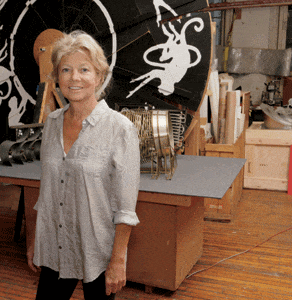The Islands of the Rose Apple Tree Surrounded by the Oceans of the World for you, Oh My Darling
Alice Aycock 1987
Background Information
Alice Aycock is an American sculptor and installation artist, and now the Director of Sculpture at Yale University. Aycock was born in Pennsylvania and grew up to focus her work on large-scale, generally outdoors installations. She received her Bachelor’s Degree of Arts from Douglass College in New Jersey, and received her Masters of Arts from Hunter College in New York.
Alice was a prominent early artist in the 1960-1970s Land Art Movement, an art form with great emphasis on the natural world and incorporating works of art with the physical landscape. In cohesion with the environment, popular materials incorporated in Land Artwork included natural materials such as soil, bedrock, water, asphalt, concrete, and metals of mineral pigment. Alice incorporated these materials in many installations such as those in her 1982 Blade Machines work, made of metal, and in her Western Washington University sculpture, made of concrete. Aycock’s other recent installations are constructed of white aluminum powder, concrete, metals, etc.
Interpretations
The Islands of the Rose Apple Tree Surrounded by the Oceans of the World for You O’ My Darling on Western Washington University’s campus is an installation 3D art piece, unique to the other installations of Western Washington University’s Public Art Collection. Though abstract and open to interpretation, the sculpture seems to be a very representative of land art characteristics.
A candid observer might regard The Islands of the Rose Apple Tree Surrounded by the Oceans of the World for you, Oh My Darling as something from a piece of science fiction, perhaps an intergalactic ship of some kind. However, the following observation recalls the infamous quote from Andrei Tarkovsky’s 1972 science fiction film Solaris, wherein the character Stanislaw Lew remarks (regarding the human drive to explore space itself):
“Man has gone out to explore other worlds and other civilizations without having explored his own labyrinth of dark passages and secret chambers, and without finding what lies behind doorways that he himself has sealed.”
Aycock was first inspired to create the installation when her brother fell sick of Cystic Fibrosis. She considered the sculpture a farewell to him, hence the its sentimental title. The installation’s spiritual rhetoric is influenced by divinie Tantric drawings, the Meru Mountain of India, and the Garden of Eden. In contrast to this however, Alice has made many statements that since her brother’s death, she finds no reality in illusions or complexity, emphasizing an ‘it is what it is’ mentality; spirituality is seen by her as a mirror reflecting nothing. This being said, she still draws on some spiritual aspects and practices in her own art, though not necessarily finding spirituality inspirational.
With our video, we demonstrate the physical results and abstract ideas surrounding the piece. Aycock’s Islands of the Rose Apple is fundamentally a piece about spirituality and the practice of it as a form of reflection or grief. It draws on spiritual practices from around the world, ranging from burial of the Etruscan dead, water gardens as seen in Islamic representations of paradise, and Tantric drawings, which serve as an artistic tool to feel closer to a god or spirit through meditation.
- Etruscan Carvings
- Mount Meru, India
- Tantric Patterns
The secluded fairytale-like positioning of the sculpture involves trees and buildings enveloping the sculpture to create a refuge from the bustle of university life which otherwise would suffocate the piece. The installation interacts with nature in more ways than one. The carvings are deep to the ground within the sculpture, leaving space for rain and leafs to fill the holes, there is a single small circle in the center which is a fountain and has a puddle of water filling it when off, and there are stairs coming down beside the sculpture creating a lookout spot to observe the sculpture from a bird’s eye view. It’s unity with the environment applies to land art and its values, enhancing the installation from just merely being a sculpture to something that is one with nature.
With minimalist materials, of concrete, earth, and water, the installation is contemplative. The sculpture’s detailing and circular shape reflects Etruscan carved roads, mandala or tantric circular structure, and Mount Meru as considered the center of the world. Our group emphasizes that the sculpture is a place for contemplation and refuge; a place of spiritual power and grief with only nature as witness.
Video
Created by Cara Libman, Adrian Mander, Sahil Kaur
Roles:
- Adrian rented equipment from the Student Technology Center and recorded the structure through video and played a large part editing the video and creating its script
- Cara attended the admin workshop, submitted project parts to canvas and WP, synthesized all of our individual work into a cohesive whole, and contributed to creating the video script
- Sahil rented books from the library for resources on Alice Aycock, contributed to creating the video script, and provided insight on her knowledge of Tantric patterns and Mt Meru
- We all contributed to all writing pieces within parts of the project, collaborated on what pictures and audio to include in our video, and met several times to organize our project
References
“About the Artist.” About Alice Aycock, www.aaycock.com/about.
Aycock, Alice, speaker. Alice Aycock on her 40 Year Career., SVA, Youtube, 2014, www.youtube.com/watch?v=d9VsJpvB0Sk.
Aycock, Alice. The Islands of the Rose Apple Tree Surrounded by the Oceans of the World for You, Oh My Darling | Western Gallery, www.westerngallery.wwu.edu/sculpture/islands-rose-apple-tree-surrounded-oceans-world-you-oh-my-darling
Hobbs, Robert. Alice Aycock: Sculpture and Projects. MIT Press, 2005. “Land Art.” Saylor Academy Resources, https://resources.saylor.org/wwwresources/archived/site/wp-content/uploads/2011/05/Land-Art.pdf


















Leave a Reply